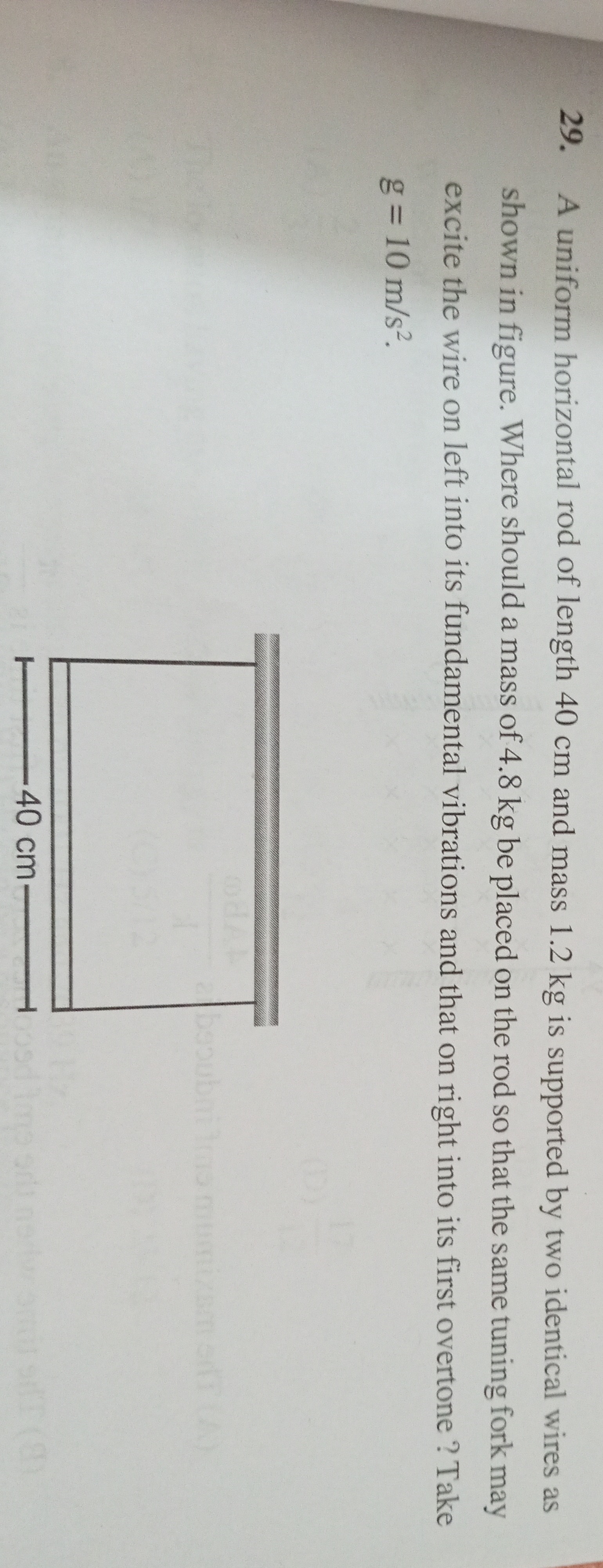Question
Question: A uniform horizontal rod of length 40 cm and mass 1.2 kg is supported by two identical wires as show...
A uniform horizontal rod of length 40 cm and mass 1.2 kg is supported by two identical wires as shown in figure. Where should a mass of 4.8 kg be placed on the rod so that the same tuning fork may excite the wire on left into its fundamental vibrations and that on right into its first overtone ? Take g = 10 m/s².

5 cm from the left end
Solution
The frequency of vibration of a stretched wire is given by f=2lnμT, where n is the mode number, l is the length of the wire, T is the tension in the wire, and μ is the linear mass density of the wire.
The two wires are identical, so they have the same length l and linear mass density μ.
The left wire is in its fundamental vibration, so n1=1. Its frequency is f1=2l1μT1.
The right wire is in its first overtone, so n2=2. Its frequency is f2=2l2μT2=l1μT2.
Since the same tuning fork excites both wires, f1=f2.
2l1μT1=l1μT2
21T1=T2
T1=2T2
T1=4T2.
Let the length of the rod be L=40 cm =0.4 m. The mass of the rod is M=1.2 kg. The rod is uniform, so its weight Mg acts at the center, which is at L/2=20 cm from either end. The mass to be placed is m=4.8 kg. Let the mass m be placed at a distance x from the left end of the rod.
For vertical equilibrium of the rod, the sum of upward forces equals the sum of downward forces:
T1+T2=Mg+mg
Substitute T1=4T2:
4T2+T2=(M+m)g
5T2=(M+m)g
T2=5(M+m)g
T1=4T2=54(M+m)g.
For rotational equilibrium, the sum of torques about any point is zero. Let's take the torques about the left end of the rod.
The tension T1 acts at the left end, so its torque is zero.
The weight of the rod Mg acts at the center, distance L/2 from the left end. The torque is (Mg)×(L/2).
The weight of the mass mg acts at distance x from the left end. The torque is (mg)×x.
The tension T2 acts at the right end, distance L from the left end. The torque is (T2)×L.
Taking the left end as the pivot, the clockwise torques are due to the weights, and the counter-clockwise torque is due to T2.
(Mg)×(L/2)+(mg)×x=T2×L
Substitute the values: M=1.2 kg, m=4.8 kg, L=0.4 m, g=10 m/s².
T2=5(1.2+4.8)×10=56.0×10=560=12 N.
(1.2×10)×(0.4/2)+(4.8×10)×x=12×0.4
12×0.2+48×x=4.8
2.4+48x=4.8
48x=4.8−2.4
48x=2.4
x=482.4=48024=201=0.05 m.
The distance x is measured from the left end. So the mass should be placed at a distance of 0.05 m = 5 cm from the left end of the rod.
